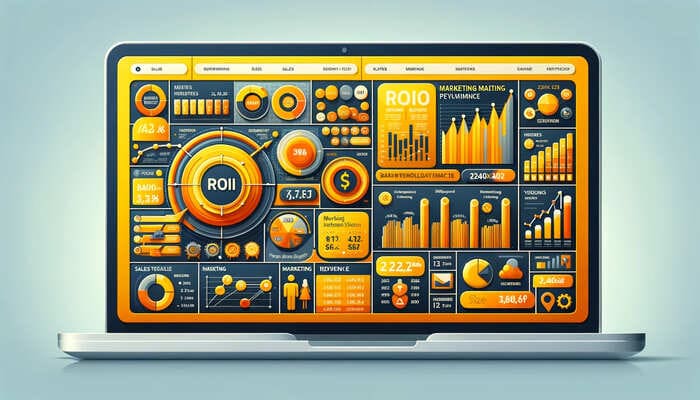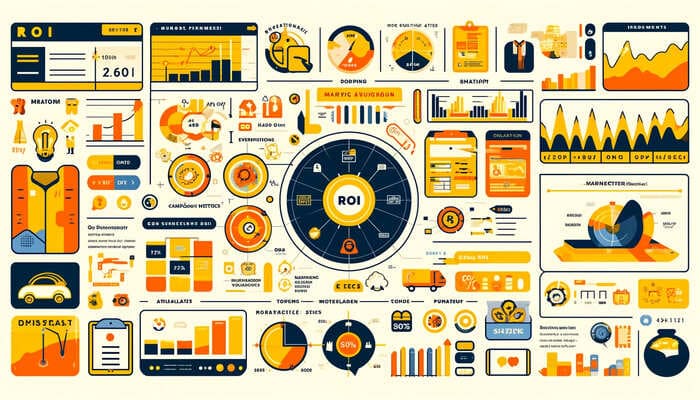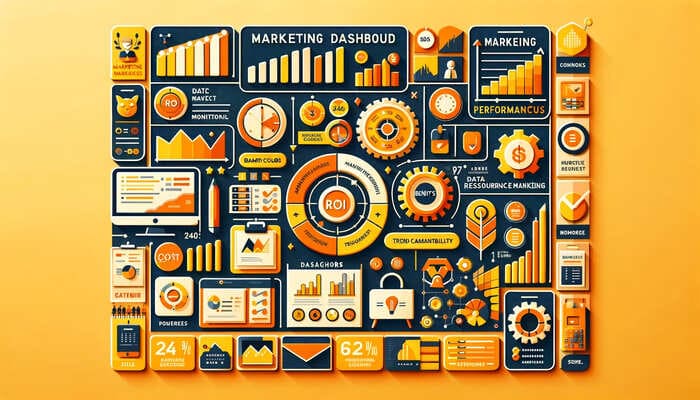Explore the chapters:
Data plays a pivotal role in shaping marketing strategies. Businesses must effectively gather, manage, and analyse data to remain competitive and make informed decisions. However, the abundance of data presents a challenge for marketing teams. How can we turn this wealth of data into actionable insights that drive marketing strategies? The solution lies in utilising a marketing dashboard.
In this article, we’ll delve into various types of marketing dashboards, their significance, and their contribution to marketing analytics efforts.

As you know, a marketing dashboard serves as a centralised tool aimed at offering marketers a holistic view of their marketing performance in real time. Its core objective is to streamline data management and analysis, enabling marketers to swiftly make informed decisions.
A Marketing ROI dashboard operates similarly but it zeroes in on essential business metrics. Its goal is to provide a clear and unified view, highlighting the marketing and sales efforts that have the most impact on revenue.

Tracking return on investment (ROI) is vital for any successful business, regardless of its size.
It provides the most accurate insight into which marketing investments yield positive returns and which do not.
While some marketers prioritize lead quantity to boost revenue, leads alone do not guarantee income. Without conversions, they hold little value for your business.
For instance, consider two simultaneous Google Ads campaigns, both running for 30 days with a $1,000 budget:
– Campaign A generated 25 leads at $40 per lead.
– Campaign B produced 9 leads at $111.11 per lead.
Initially, you might lean towards investing more in Campaign A due to its higher lead count. However, if we factor in the revenue generated:
– Campaign A resulted in $2,000 in sales, equating to a 200% Return on Ad Spend (ROAS).
– Campaign B, despite fewer leads, garnered $10,000 in revenue, achieving a ROAS of 1000%.
In this scenario, Campaign B proves to be the more lucrative investment, showcasing the importance of focusing on revenue rather than just lead quantity.
By prioritizing revenue-driven metrics, businesses gain valuable insights into their marketing performance. This allows them to optimize their strategies, allocate resources effectively, and achieve more cost-effective results.

A marketing ROI dashboard typically comprises several key components to effectively measure and analyze the performance of marketing campaigns and initiatives. Here are some essential elements:
By incorporating these key components into a marketing ROI dashboard, businesses can gain valuable insights into the effectiveness of their marketing strategies and make data-driven decisions to optimize their ROI.

Utilizing marketing ROI dashboards offers numerous benefits for businesses looking to optimize their marketing efforts and maximize their return on investment. Here are some key advantages:
Overall, marketing ROI dashboards provide a comprehensive framework for measuring, analyzing, and optimizing marketing performance, ultimately driving business growth and profitability.

When building a marketing ROI dashboard, it’s important to track a variety of metrics that provide insight into different aspects of marketing performance and return on investment. Here are some essential metrics to include:
By tracking these metrics on a marketing ROI dashboard, businesses can gain valuable insights into the effectiveness of their marketing efforts and make data-driven decisions to optimize ROI and drive business growth.
Schedule a free consultation call with our team today

When choosing a marketing ROI dashboard, it’s essential to consider several factors to ensure that the dashboard meets your specific needs and provides actionable insights for optimizing marketing performance. Here’s what to look for:
By considering these factors when choosing a marketing ROI dashboard, you can select a solution that empowers your marketing team with actionable insights, drives better decision-making, and ultimately maximizes the return on your marketing investments.
Now that you understand the importance of tracking marketing ROI, let’s explore some effective solutions to help you accomplish this goal.
Looker Studio, a component of Looker’s business intelligence platform, is gaining recognition for its prowess in marketing attribution and revenue tracking. By seamlessly integrating CRM and marketing data, Looker Studio empowers businesses to attribute credit to various touchpoints along the customer journey.
This integration enables users to pinpoint which marketing campaigns contribute most to revenue, facilitating data-driven decision-making to optimize marketing strategies. Looker Studio’s user-friendly interface and drag-and-drop functionality make it accessible to marketers of all skill levels, allowing them to create custom reports and dashboards tailored to their specific needs.
Most of the features of Looker Studio are available on free plan but its paid plan is also completely available as it is priced at $9 per month. With Looker Studio, businesses can harness the power of data to drive growth and maximize return on investment without breaking the bank.
You’re likely familiar with HubSpot, renowned for its sales and marketing automation capabilities. However, it’s also gaining recognition in the marketing attribution and revenue tracking sphere.
HubSpot functions by integrating your CRM and marketing data, enabling you to attribute credit to various touchpoints throughout the customer journey. This allows you to identify which marketing campaigns contribute most to revenue and make informed decisions to enhance your strategies.
Unfortunately, HubSpot’s revenue attribution reporting is exclusive to its Enterprise package, making it inaccessible to small and medium-sized businesses. Pricing for this package starts at $890 per month (billed annually at $9600) for 10,000 contacts, with additional costs for larger contact lists.
Another valuable tool for tracking revenue-generating channels is Kissmetrics. It is a person-based analytics product designed to identify, understand, and enhance the metrics crucial for your business growth.
With its revenue report feature, you can easily determine the revenue generated from your marketing efforts. Additionally, you can break down this revenue by campaign, enabling you to identify which campaigns yield the highest lifetime value and lowest churn rate.
Kissmetrics offers three pricing tiers: Silver at $299 per month, Gold at $499 per month, and Custom pricing options tailored to your specific needs.
Plannuh is a comprehensive performance tool designed to streamline the management and tracking of your business goals, marketing budget, and ROI.
By integrating with various marketing tools used by marketers to develop plans, budgets, and reports, Plannuh provides a centralized platform for consolidating all your marketing data. This allows you to gain a holistic view of your marketing activities and their impact.
Pricing for Plannuh is based on the size of your marketing budget, ensuring that you pay according to your specific needs. For instance, if your marketing budget amounts to $650,000, you can expect to pay $750 per month for the service.
Cyfe is a robust data visualization and dashboard reporting solution designed to streamline the collection, monitoring, and analysis of key marketing and business performance metrics.
Ideal for marketers seeking to delve deeper into their metrics and gain insights beyond traditional marketing metrics, Cyfe offers a centralized platform to consolidate and analyze data from various sources.
Cyfe offers four pricing plans to cater to different business needs: Starter at $19 per month, Standard at $29 per month, Pro at $49 per month, and Premier at $89 per month. Each plan provides varying levels of features and capabilities to suit different requirements.
Ruler Analytics offers a comprehensive marketing attribution solution designed to track and attribute revenue to various marketing touchpoints within individual customer journeys.
Here’s how it works: Ruler Analytics meticulously captures and tracks every visitor’s interactions across multiple sessions, traffic sources, and keywords. Upon conversion, whether it’s through a form fill, phone call, or live chat inquiry, Ruler Analytics matches the captured contact details to the lead’s marketing touchpoints.
This conversion data and marketing source information seamlessly integrate with your CRM system, providing your sales and customer support teams with valuable insights into lead interactions and interests.
As leads progress through the sales pipeline, Ruler Analytics continuously updates the data, enabling your marketing team to accurately assess lead quality and progression within the funnel.
Upon completion of a purchase or deal, Ruler Analytics precisely attributes revenue back to the marketing channels, campaigns, keywords, and ads that influenced the conversion.
Furthermore, Ruler Analytics offers flexible integration options with nearly any marketing tool or application, ensuring convenient access to revenue and attribution data within your preferred platforms.
With pricing starting at £199 per month and various customizable plans available, Ruler Analytics offers tailored solutions to meet your specific requirements. Additionally, customers can benefit from a 20% discount by opting for annual payment, and special rates are available for agency partners.
If you are just getting started, you can start using Google’s Data Studio to start analysing your ROI with visual dashboards. However, if you are at enterprise level, HubSpot is going to be a better choice for you. You can follow this guide to setup your marketing ROI dashboards with right KPIs irrespective of the tool you choose.
Ever wondered how you can transform your paid advertising strategy to not only connect with your audience but also maximize your budget and drive substantial results? In this guide, we’ll explore how to elevate your paid ad campaigns, ensuring every dollar spent brings in the best returns. Get ready to learn how to take your advertising efforts to new heights and achieve remarkable outcomes for your startup.
638 Independence Parkway, Suite 240, Chesapeake, Virginia, USA – 23320
3 Eurospace, 4th Floor, Jyothi Imperial, Janardana Hills, Gachibowli, Hyderabad, Telangana, India – 500032
Mileta Sorokovska, Moosstrasse 19,
6003 Luzern, Switzerland
Copyright © 2024 by StartupWize